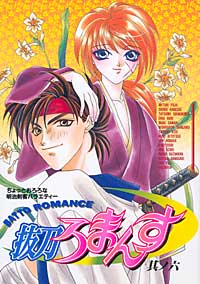
by Luis Reyes
|
Yaoi As Fantasy Fulfillment - Knowing that she has come into yaoi fandom just recently, I asked my friend Janet to speak with me about how she perceives it: Yaoi stories are about romance, the ultimate end of which is sex. One boy, usually the dominant one (Seme in Japanese), seduces another boy, usually the submissive one (Uke in Japanese). Like in other romance stories, love triangles might arise as well as jealousy, lovers spats, insensitivity to the needs of one's partner, etc. But the driving force of the story is about the romance, about the relationship itself. Most of it is inspired by popular series, especially those that have a profusion of guys. And the subject of yaoi usually focuses on a relationship between boys that aren't firmly committed to a relationship with a girl. It's difficult (but not impossible), say, to write a believable yaoi story featuring "Sorcerer Hunters'" Carrot because of his unquenchable, heterosexual libido. The imagination of good yaoi writers expands upon established relationships that could have implicit homoerotic overtones. A story that follows this guideline is called "canon," it respects the nuances of the show. "Non-canon" works tend to indulge fantasy, pairing unlikely matches for cheap thrills (a practice not necessarily frowned upon in the yaoi community).
Some series ripe for yaoi exploitation are "Rurouni Kenshin" (his relationship with Kaoru is ambiguous at best leaving the playing field wide open for pairings with Sanosuke and Yahiko), "White Cross" ("Weiss Kreuz" - a story about a group of boys who run a flower shop during the day but engage in vigilante activity at night - rife with pretty boys and plenty of underlying tension), and, my favorite, "Gundam Wing" (a show in which young boys put their lives in each other's hands). My favorite "Gundam Wing" yaoi pairing is Quatre - the idealistic, empathetic, free spirited lad - and Trowa - the quiet, subdued, apathetic malcontent. The stories about how these disparate personalities come into a relationship are not only arousing but also fascinating. Now why? Several reasons. Girls prefer two guys together because it poses less of a threat from another girl. If my favorite main character, say Quatre, were involved in a sexual pairing with an anime woman - usually a shapely, well-bosomed, inhumanly beautiful woman - I would compare myself to her, and, in my imagination, would fall far short of her. And, in turn, I would fall short of Quatre's ideal. Pairing Quatre with another boy, say, Trowa, I can envision him romantically and sexually but don't feel the threat from ridiculous notions of female beauty. Janet also notes a concept from Scott McCloud's book, "Understanding Comics" in which he explains that readers can relate to characters in comics (and inherently anime/animation) more than in live action because of the very fact that they are simplified [pages 35-37]. Drawn characters become symbols for the reader. Thus when Janet reads about Quatre and Trowa in carnal embrace, she can embody either one. |

